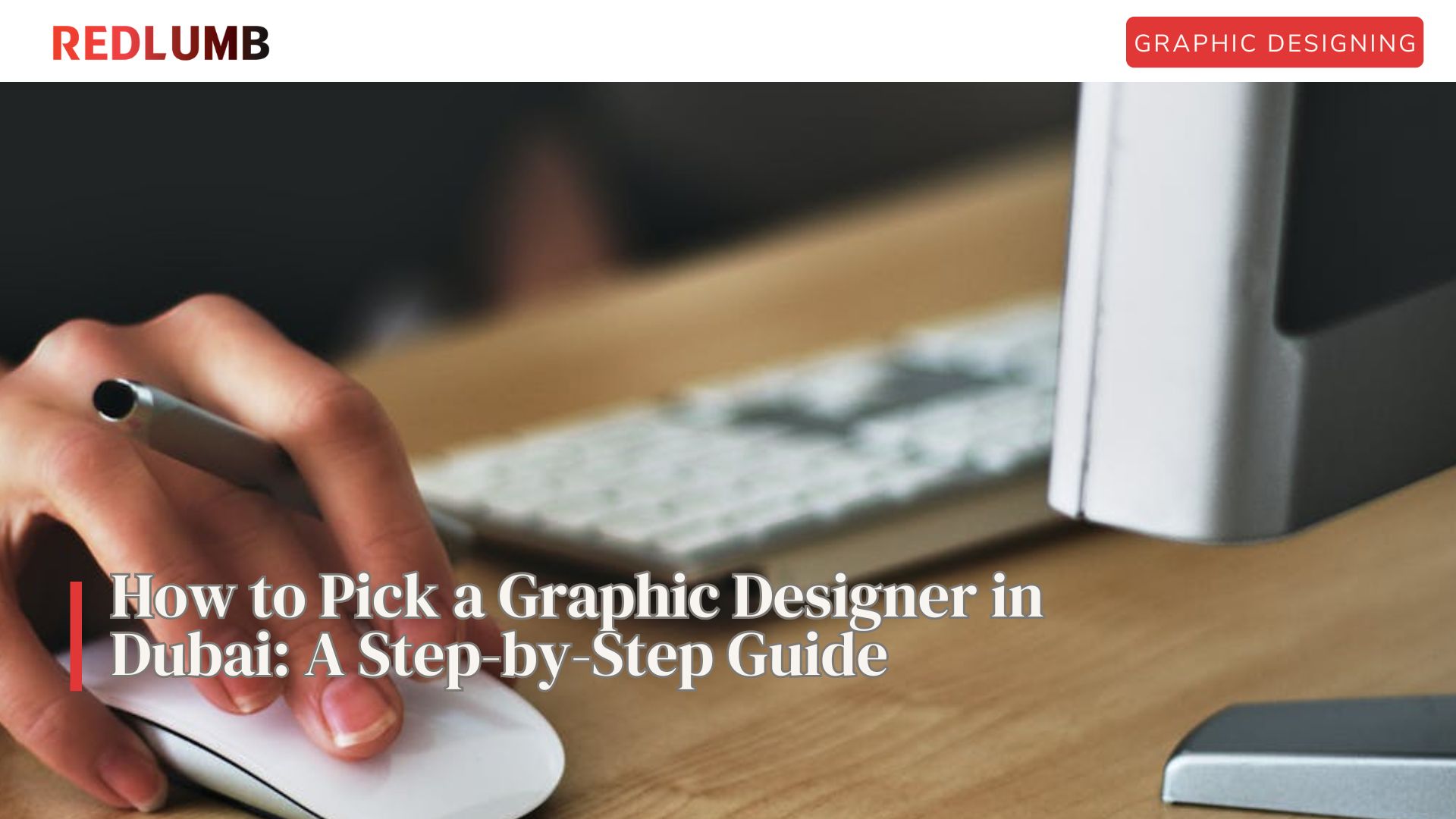As the competition soars and consumer interests continue to shift, the right visual identity can make or break a business. Finding the perfect graphic designer in Dubai isn’t just about picking someone who can create pretty pictures. It’s about choosing a professional who understands brand identity and market dynamics and can translate business objectives into compelling visual solutions.
Many businesses struggle with choosing a graphic designer, often ending up with designs that don’t align with their vision or meet their goals. The process requires careful consideration of portfolios, communication styles, and industry expertise to find the right match.
[su_list class=”story-highlight”]Key Takeaways
- Start with a detailed design brief that outlines project objectives, timelines, technical specifications, and communication processes to ensure smooth collaboration and realistic expectations.
- Assess portfolios for project diversity, technical proficiency, and case studies that demonstrate problem-solving abilities, ensuring alignment with your brand’s vision and market needs.
- Effective collaboration relies on clear communication, defined revision policies, and structured workflows, which are essential for maintaining project momentum and achieving desired results.[/su_list]
Define Your Project Requirements
Successful graphic design projects begin with clearly defined requirements. A comprehensive design brief serves as the foundation for effective collaboration between businesses and designers in Dubai’s competitive market.
The first crucial step is creating a detailed scope of work. This document should outline project objectives, deliverables, and timelines in a structured manner to avoid misunderstandings and scope creep. A well-defined scope helps both parties understand what is included and what isn’t in the design project.

Essential elements to include in your project requirements:
- Project objectives and desired outcomes.
- Target audience demographics and preferences.
- Brand guidelines and design specifications.
- Technical requirements (file formats, dimensions).
- Timeline milestones and delivery dates.
- Budget constraints and payment terms.
When defining technical specifications, businesses should consider that graphic designers need to be proficient in various design software and principles. Modern designers should have expertise in Adobe Creative Suite, typography, color theory, and branding principles. This ensures the final deliverables meet both creative and technical standards.
It’s crucial to factor in potential project complexities and timeline adjustments. Research shows that successful design projects often include provisions for delays in client approvals and interface with external vendors. By accounting for these variables in the initial requirements, businesses can establish realistic expectations and ensure smooth project execution.
[su_service title=”Important” icon=”icon: exclamation-triangle” icon_color=”#00ae27″ size=”20″ class=”ImportntBox”]Remember that clear communication channels and feedback processes are essential components of project requirements. Define how and when you will communicate with the designer, including the number of revisions allowed and the timeline for feedback. This structured approach helps maintain project momentum and ensures all stakeholders remain aligned throughout the design process.[/su_service]
Evaluate Designer Portfolios
A designer’s portfolio serves as a window into their professional capabilities and creative approach. When evaluating portfolios in Dubai’s competitive design market, businesses should look beyond just aesthetic appeal to assess comprehensive design competency.
A well-curated portfolio should showcase 6 to 12 items of the designer’s best and most recent work. Key elements to evaluate include:
- Project diversity and versatility.
- Technical proficiency in design software.
- Quality of visual presentation.
- Case studies and problem-solving approach.
- Client testimonials and project outcomes.
When reviewing portfolios, businesses should focus on work samples that are less than four years old, as this indicates the designer’s current capabilities and familiarity with modern trends. The portfolio should demonstrate proficiency in industry-standard tools like Adobe Creative Suite, including Photoshop, Illustrator, and InDesign.
Case studies within the portfolio deserve special attention as they reveal the designer’s strategic thinking and problem-solving abilities. These should outline the project objectives, challenges faced, and solutions implemented. A strong portfolio will include detailed documentation of the design process, from initial research to final execution, demonstrating the designer’s methodical approach to projects.
Professional portfolios should also showcase the designer’s ability to maintain brand consistency while incorporating creativity. This balance is particularly crucial for businesses in Dubai seeking to establish or enhance their visual identity in a competitive market. The presentation quality itself matters – high-resolution images and professional formatting enhance credibility and showcase attention to detail.
Assess Communication and Workflow
Effective communication and streamlined workflow processes form the cornerstone of successful design projects in Dubai’s competitive market. Research shows that 86% of workplace failures are attributed to a lack of collaboration, making it crucial to assess these aspects when selecting a graphic designer.

A professional graphic designer should demonstrate strong communication skills by effectively translating abstract concepts into tangible designs. Key aspects to evaluate include:
- Ability to ask appropriate questions about project goals.
- Clear explanation of design processes and decisions.
- Proactive approach to feedback and revisions.
- Structured workflow management.
- Regular progress updates and milestone tracking.
[su_service title=”Info” icon=”icon: info-circle” icon_color=”#000″ size=”20″ class=”InfoBox”]The designer’s revision policy deserves particular attention, as it directly impacts project timelines and outcomes. Studies indicate that only 23% of designers believe marketers provide clear project briefings, while less than 40% of marketers feel designers effectively follow briefs. Therefore, establishing clear revision limits and additional cost structures upfront is essential.[/su_service]
Workflow Assessment should focus on the designer’s process, including wireframe creation, mockup development, and final file preparation. The designer should demonstrate a systematic approach to project management, with defined stages for internal reviews before client presentations.
Professional designers should maintain open communication channels and provide regular updates about project status. This includes setting clear expectations for meeting frequency and communication methods, and ensuring all stakeholders remain informed throughout the design process.
How Can Businesses Build Successful Graphic Design Partnerships?
Selecting the right graphic designing services in Dubai requires careful consideration of multiple factors that extend beyond creative abilities. Businesses must balance technical expertise, communication skills, and strategic thinking to find professionals who can deliver meaningful results.
Success in graphic design partnerships stems from thorough preparation and clear expectations. Companies that invest time defining project requirements, studying portfolios, and evaluating communication styles position themselves for better outcomes. This systematic approach helps businesses avoid common pitfalls and ensures their design investments generate real value.
Dubai’s dynamic business environment demands excellence in visual communication. Organizations should focus on designers who demonstrate both creative talent and professional reliability through their work samples, processes, and client interactions. This combination of skills ensures design projects not only look impressive but also achieve strategic business objectives.
The right graphic designer becomes a valuable partner in building brand identity and market presence. Through careful evaluation of portfolios, clear project specifications, and strong communication protocols, businesses can find designers who transform their vision into compelling visual solutions that resonate with target audiences and drive business growth.
Moiz Banoori is a Digital Marketing specialist with over eight years of experience in content creation and digital journalism. He leads teams at various brands and focuses on developing effective SEO strategies that enhance online visibility. With a degree in journalism, Moiz combines his passion for storytelling with technical skills to deliver innovative digital solutions at REDLUMB, helping clients achieve their online goals in a competitive landscape.



